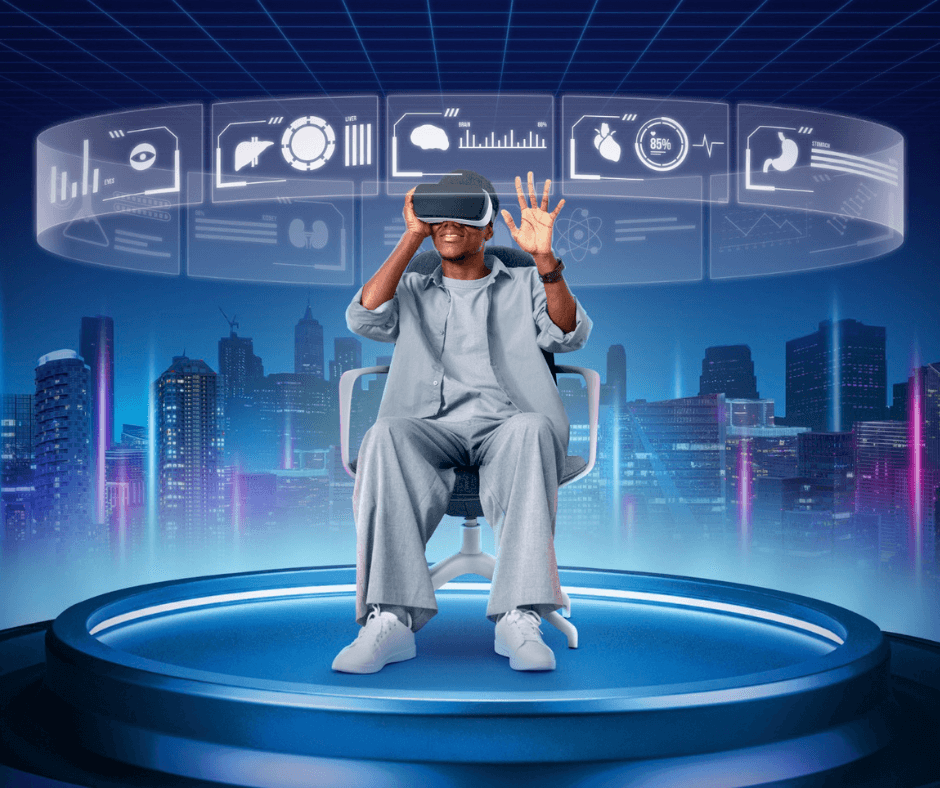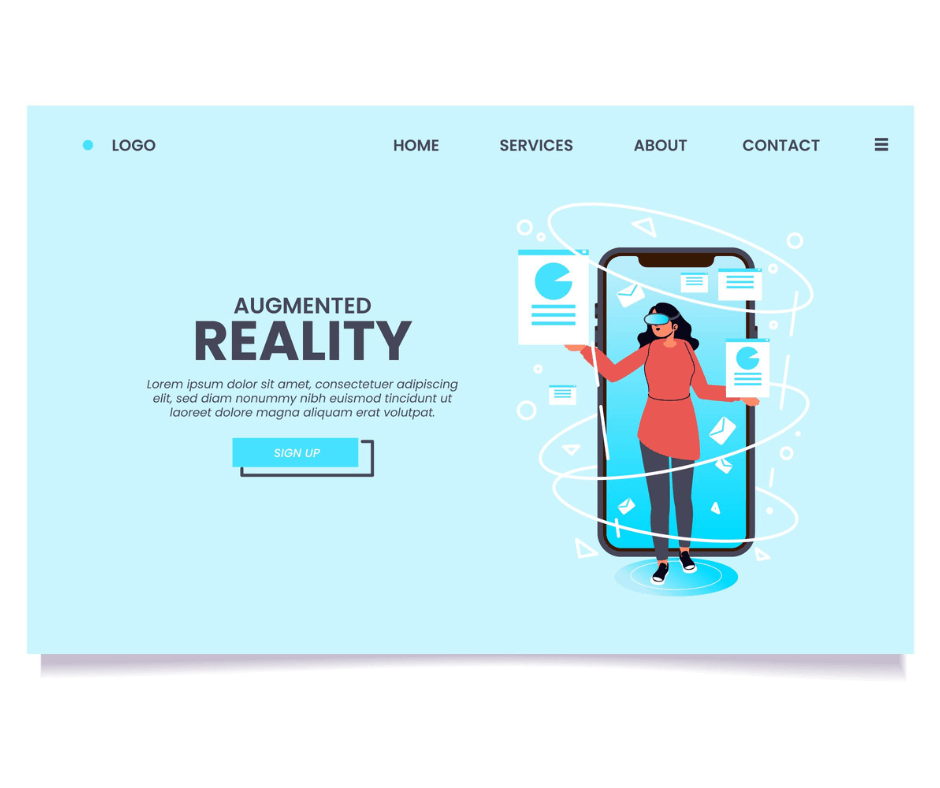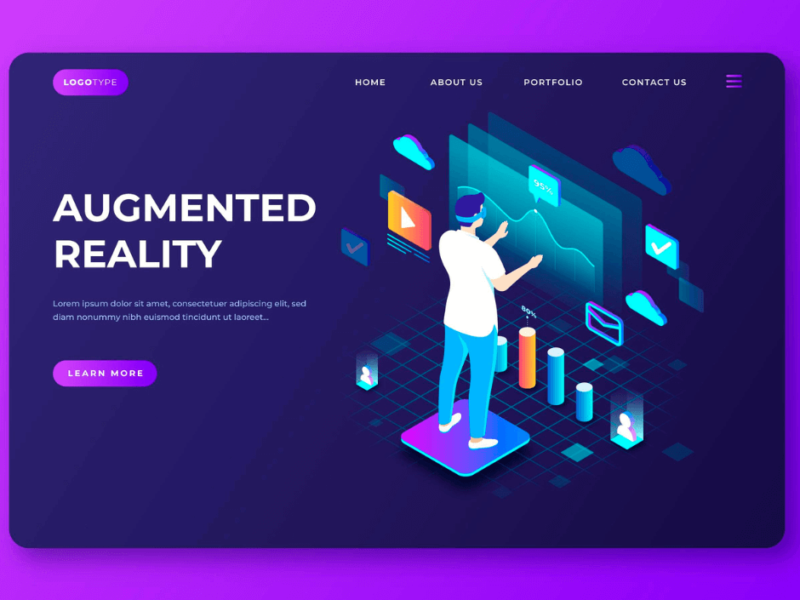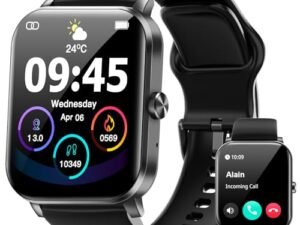Technology is advancing, and so is the world of augmented reality (AR). AR is a technology that adds digital information to the real world. Users can try a different kind of reality.
AR has the power to revolutionize education and entertainment. It can change how we interact with the world.

In the future, augmented reality will cause significant changes in industries.
AR can enhance education by providing immersive experiences for students. These experiences go beyond textbooks and make learning more engaging and interactive.
AR can aid doctors during surgeries and show patients their conditions.
AR in marketing creates new opportunities. Businesses engage with customers and provide unique experiences.
Understanding Augmented Reality and the Rise of Augmented Reality
Looking forward, we must understand augmented reality and its workings. This technology is on the rise.
Augmented reality (AR) enhances parts of a user’s physical world. It’s computer-generated input.
The range of options includes sound, video, graphics, and GPS overlays. These options respond in real-time to changes in the user’s environment.
We can see AR as a layer in the real world. It gives users more information and improves their experience.
Imagine walking down the street. You see a restaurant to try. With AR, you can use your phone to see reviews, ratings, and even a menu on the restaurant.
AR differs from virtual reality (VR) in that it doesn’t create an entirely new world for users. Instead, it adds to the world we already know, making it more dynamic and interactive.
There are a few key components that make AR possible. These include:
-
Hardware: Users need a device with hardware to display computer-generated input. This can be a smartphone, tablet, or specialized AR headset.
-
Software: AR experiences are made with software that recognizes and tracks real-world objects. The computer-generated input can seamlessly overlay the user’s environment. It looks natural.
-
Sensors: AR software relies on different sensors. These sensors include cameras, accelerometers, and GPS. They track the user’s movements and environment. The computer-generated input can respond in real-time to changes. The response is based on the user’s surroundings.
We are discovering augmented reality and its endless possibilities. We will witness many innovative use cases as a result.
AR can transform how we interact with gaming, entertainment, education, and healthcare.
Historical Context of Augmented Reality
https://www.youtube.com/watch?v=_m44ynMTogY&embed=true
Looking ahead to the future of augmented reality, understanding its history is crucial. Augmented reality has been around for much longer than many people realize.
The technology started in 1968. Ivan Sutherland, a computer scientist at Harvard, began it.
Sutherland made a device. The device could put computer graphics in the real world.
Since then, augmented reality has come a long way. Experiments with augmented reality began in research labs in the 1980s and 1990s.
Videoplace was an early example. It used projection and camera technology. It created interactive experiences for users.
Augmented reality has started being used in different industries and business apps. This happened in the years that came after.
The sports industry was one of the first to use augmented reality technology. They started using it in the late 1990s for training.
Augmented reality is now widely used in various applications. These include gaming, entertainment, healthcare, and education.
We expect exciting developments in augmented reality in the coming years. These will be due to the rise of mobile devices and new technologies like smart glasses.
Technical Aspects of Augmented Reality
Looking into the future of augmented reality, we must understand its technical aspects.
In this section, we will explore the hardware requirements of augmented reality. We will also discuss the software development aspects of augmented reality.
Hardware Requirements
The hardware requirements for augmented reality vary. It depends on the type of AR experience being developed.
A basic AR app overlays digital info on an object. Requires a smartphone or tablet with a camera.
A complex AR experience may need specialized hardware like HMDs or smart glasses. This includes real-time tracking and rendering.
HMDs are wearable devices. They use cameras, sensors, and displays. They create an immersive AR experience.
These devices are commonly used in industrial or enterprise settings. They provide hands-free access to important information.
Smart glasses are designed for consumers. They offer a lightweight and stylish alternative to HMDs.
Software Development
The process of developing augmented reality software is like that of other software. The development process for augmented reality software is similar to others.
However, when developing AR applications, developers must address some unique challenges. Real-time tracking and rendering of digital content is a big challenge. It happens in the real world.
AR developers use computer vision, machine learning, and 3D graphics. They combine these to create immersive AR experiences. This helps them overcome the challenge.
Computer vision tracks the real-world environment and identifies objects and surfaces. Machine learning recognizes and classifies objects in real-time.
3D graphics render digital content in the real world. Users interact with virtual objects as if they were real.
The success of augmented reality depends on hardware and software. Both hardware requirements and software development are crucial for this technology. Augmented reality’s success relies on its hardware and software components.
The Rise of Augmented Reality is ongoing. We will see advanced hardware and software solutions. They will enable immersive and interactive AR experiences.
Impacts of Augmented Reality
Augmented reality (AR) technology is growing and will impact many industries.
AR is expected to change the game in education, healthcare, entertainment, and retail.
Education
AR technology can revolutionize the way we learn. AR can enhance education by overlaying digital information in the real world. This makes learning more interactive, engaging, and immersive.
Students can use AR to explore historical sites. They can also visualize complex scientific concepts. Additionally, they can practice language skills by interacting with virtual objects and characters.
Healthcare
AR can also have a significant impact on the healthcare industry. AR helps doctors and healthcare professionals visualize complex medical procedures. It also enhances training simulations to be more interactive and realistic.
AR can also offer patients personalized and informative experiences. For example, they can visualize the effects of various treatments or medications.
Entertainment
The entertainment industry is embracing AR technology. We can expect exciting future developments.
AR can enhance consumer experiences by overlaying digital elements with live events. AR can also create new and interactive forms of gaming.
AR can enhance existing media. It adds interactive elements to movies or TV shows.
Retail
AR can also have a significant impact on the retail industry. Retailers can use AR to offer customers interactive, personalized experiences.
They can virtually try on clothes or visualize furniture at home. This helps them make informed purchase decisions.
AR can create engaging product displays, providing customers with detailed information. It showcases products in an interactive way.
AR technology has the potential to revolutionize industries and interact with us.
Future Prospects of Augmented Reality

The use of augmented reality (AR) is growing rapidly. We can expect exciting developments in the future. Here are some of the most promising prospects for the future of AR:
Increased Adoption in Industries
Many industries, including healthcare, education, and retail, have already adopted AR. However, we can expect to see even greater adoption in the future.
AR can train employees in various industries. This helps them acquire new skills. The training is interactive, making it engaging for learners.
AR can create immersive shopping experiences. Customers can try on clothes or see furniture in their homes. This helps before making a purchase.
Improved User Experience
AR technology is advancing, so the user experience will improve. AR glasses and headsets will become more comfortable and lightweight. This will make them easier to wear for extended periods of time.
Improvements in AR tracking may enhance accuracy and speed. This enhancement allows for more realistic and seamless AR experiences.
Integration with Other Technologies
AR is already being integrated with other technologies. These technologies include artificial intelligence (AI) and the Internet of Things (IoT).
In the future, we will witness increased integration of technology. This integration will lead to more advanced and sophisticated AR experiences. AR could be used with AI to create personalized experiences. AR could also be used with AI to create context-aware experiences.
New Applications
As AR technology continues to evolve, we can expect to see new and innovative applications emerge. AR can create immersive gaming experiences. Players interact with virtual objects in the real world.
AR can create engaging social media experiences. Users share AR content with friends and followers.
Overall, the future of AR looks bright, with many exciting developments on the horizon. Technology keeps advancing. We will see more exciting AR experiences. They will change how we interact with the world.
Potential Challenges and Solutions
As with any new technology, the rise of augmented reality (AR) comes with its own set of challenges. In this section, we will discuss potential challenges and solutions. We may encounter these challenges as AR becomes more prevalent.
Technical Limitations
One of the biggest challenges that AR faces is technical limitations. AR requires a lot of processing power. It also requires high-quality graphics. This is to create a seamless experience. However, current hardware may not be able to meet these requirements.
The limited battery life of AR devices is also a concern. Hardware manufacturers are always improving their products to meet AR application demands. They do this to address the challenges they face.
Legal Concerns
Regulators and lawmakers are left playing catchup with advancing technology. Legal systems cannot keep up with its speed. XR is no exception.
As a result, we don’t have clear guidelines on how to deal with legal issues that may arise from AR technology.
AR can create realistic product simulations, potentially leading to copyright infringement. This can result in legal issues. We must work with lawmakers to address challenges in AR technology. Together, we can develop clear guidelines and regulations.
User Experience
Overall, the rise of augmented reality is set to change the way we experience the world. The technology is developing. We will see new AR applications that enhance daily life.
AR has the potential to revolutionize our interaction with the world. However, it is vital to ensure a seamless and intuitive user experience.
One of the biggest challenges in this regard is creating an AR experience that is comfortable for users to use. AR can cause physical discomfort, such as eye strain and headaches, if not designed properly.
Designers must consider users’ physical limitations and create comfortable AR applications.
Security and Privacy
AR applications can gather user information like location and personal data. This raises concerns about security and privacy.
AR developers must implement security measures to address concerns. These measures include data encryption and user authentication.
AR applications should be clear about the data they collect. They should also explain how the data is used. This transparency is important for user trust.
In conclusion, AR has the potential to change our interactions with the world. However, addressing the challenges that come with its rise is important.
By collaborating, we can overcome challenges and create seamless AR. Working together, we can make AR intuitive and seamless. By addressing these challenges, we can create an intuitive AR experience. This benefits everyone. 
Conclusion
In conclusion, the rise of augmented reality will bring significant changes. These changes will affect various aspects of our lives.
Advancements in hardware, software, and artificial intelligence have improved. We can expect more immersive and realistic augmented reality experiences. These improvements will happen in the future.
Our research has shown that augmented reality has a history dating back to the 1960s. However, it has only gained popularity in recent years.
The adoption of augmented reality is increasing. We will see more applications in healthcare, education, and entertainment.
The rise of augmented reality is expected to bring new opportunities for businesses. They can engage with customers in more interactive ways.
Retailers can use augmented reality to offer customers a virtual try-on experience. This allows customers to see how products look on them before buying.
The rise of augmented reality is exciting. It has the potential to reshape our everyday experiences.
We look forward to seeing how this technology continues to evolve and impact our lives in the years to come.
Frequently Asked Questions
How is augmented reality different from virtual reality?
Virtual reality (VR) fully immerses users in a virtual world. Augmented reality (AR) enhances the real world with digital elements.
In other words, VR creates a new environment, while AR adds to the existing environment.
What are the main purposes of using augmented reality?
AR has many applications, including entertainment, education, healthcare, marketing, and more. AR can be used to create interactive museum exhibits.
It can also be used to train medical professionals. Additionally, it can provide customers with a virtual try-on experience when shopping for clothes.
What is mixed reality, and how does it differ from AR and VR?
Mixed reality (MR) combines AR and VR. Digital elements integrate into the real world and interact with objects.
MR and AR are different. MR allows complex interactions between digital and physical elements. It also differs from VR because it lets users engage with the real world.
How can businesses benefit from implementing augmented reality?
AR can assist businesses in engaging customers through interactive experiences. This can lead to increased brand awareness and customer loyalty.
AR can improve employee training by providing hands-on experience. AR can also enhance productivity by creating a safe environment.
What are some real-world examples of using AR and VR in the workplace?
AR and VR are used in the workplace for various purposes. For instance, AR can be used to assist technicians in the field remotely. Additionally, VR can simulate hazardous or intricate scenarios for training.
AR and VR can be used in design and prototyping. Designers can visualize and test products in a virtual environment.
What is the projected growth of augmented reality, and how will it impact the future?
The AR market is projected to grow from $3.5 billion in 2017. According to a report by MarketsandMarkets, it will reach $198 billion by 2025.
The growth is expected to be driven by increased adoption. Industries such as healthcare, education, and retail will contribute.
AR has the power to transform how we interact with technology. It can also change how we engage with the world around us. Its impact on society will likely be substantial.







